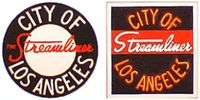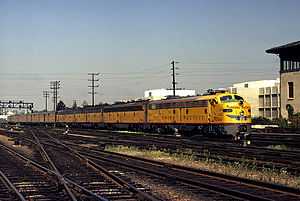City of Los Angeles (train)

The City of Los Angeles was a streamlined passenger train between Chicago, Illinois, and Los Angeles, California via Omaha, Nebraska, and Ogden, Utah. Between Omaha and Los Angeles it ran on the Union Pacific Railroad; east of Omaha it ran on the Chicago and North Western Railway until October 1955 and on the Milwaukee Road thereafter. The train had number 103 westbound and number 104 eastbound.
This train was the top-of-the-line for UP, which marketed it as a competitor to the Super Chief, a streamlined passenger train on the Atchison, Topeka and Santa Fe Railway, and the Golden State, a streamlined passenger train jointly operated by the Rock Island and Southern Pacific railroads. As with the City of Los Angeles, many of the train's cars bore the names of locales in and around its namesake city.
CNW / UP used one of two three-unit sets of EMC E2 locomotives as motive power beginning in 1937. The UP scored a public relations coup in the mid-1950s when the City of Los Angeles was featured in two episodes of the popular television series I Love Lucy. In 1955 the Milwaukee Road assumed the service, replacing the Chicago and North Western between Chicago and Omaha. Actor Ronald Reagan often traveled on this train and even did a full page print ad for it that appeared in the National Geographic magazine. In a cost-cutting move, the City of Los Angeles was combined with the City of San Francisco in 1960.
History
Timeline
- May 15, 1936: City of Los Angeles makes its first run between Chicago, Illinois and Los Angeles, California. One trainset (the M-10002), so leaves each terminal five times a month.
- 1938: 14-car 791-ton train powered by three EMC E2s enters service alongside the older trainset, allowing departures ten times a month.
- 1941: New train powered by E6s enters service, replacing the articulated trainset; frequency remains ten departures per month. The Hollywood, a lounge car built for the City of Los Angeles, is the first passenger car with an interior built entirely of synthetic materials, including the newly invented formica (plastic) and naugahyde.
- 1947: City of Los Angeles begins running daily.
- 1955: Astra Dome dome cars are added to the City of Los Angeles. The Milwaukee Road takes over operation of the City of Los Angeles from the Chicago and North Western Railway between Chicago and Omaha.
- 1956: Challenger and City of Los Angeles are combined and operate on the City of Los Angeles schedule. (The Challenger operated on its own schedule during a couple of summers thereafter.)
- 1970: Dome dining cars retired and replaced with standard flat top cars.
- May 1, 1971: Amtrak takes over long-distance passenger operations in the United States.
- May 2, 1971: UP-operated long-distance rail service ends when the City of Los Angeles arrives at Los Angeles Union Station.
In 1979 Amtrak created the Desert Wind, running mostly on the City of LA route from Los Angeles to Ogden, Utah where it connected to the Oakland-Chicago train. (After a year or two some of its cars ran through to Chicago.) The Desert Wind ceased operation in 1997.
Other railroad uses of the name City of Los Angeles
The City of Los Angeles name has also been applied to a 48-seat diner built by the St. Louis Car Company in 1949. The car was originally UP No. 4808 and is currently owned and operated by the Union Pacific as part of their excursion fleet.
Equipment used
A typical City of Los Angeles train consist around 1955 included:
- EMD E9 A-B-A diesel locomotive set
- Mail express 5707
- Baggage 5606
- Baggage dormitory 3107
- Placid series sleeper 11-double bedroom Placid Lake
- Placid series sleeper 11-double bedroom Placid Dune
- Sleeper 4-4-2 Imperial Hill
- Astra Dome diner 8008
- Sleeper 4-4-2 Imperial Club
- Sleeper 5-2-2 Ocean Beach
- Sleeper 5-2-2 Ocean Bay
- Astra Dome lounge observation 9009
-
Domeliner diner upper level.
-
Domeliner diner lower level.
-
The Gold Room, a private dining room available by reservation.
-
Astra Dome observation car.
-
Astra Dome lower level.
-
Observation car room for playing cards.
-
The Redwood Lounge.
-
Pullman car in day mode.
-
Pullman private compartment.
-
Seating in a coach car.
-
"The Little Nugget"-one of the streamliner's club cars.
Station stops
Station stops, 1950[1]
- Chicago, IL (Chicago & North Western)
- Clinton, IA
- Cedar Rapids, IA
- Ames, IA
- Boone, IA
- Omaha, NE (Union Pacific)
- Fremont, NE (departing passengers only)
- Columbus, NE (departing passengers only)
- Kearney, NE (departing passengers only)
- Grand Island, NE
- North Platte, NE
- Sidney, NE
- Cheyenne, WY
- Laramie, WY
- Rawlins, WY
- Green River, WY
- Evanston, WY
- Ogden, UT
- Salt Lake City, UT
- Milford, UT
- Las Vegas, NV
- San Bernardino, CA
- Riverside, CA
- East Los Angeles, CA
- Los Angeles, CA
Time Table
Sample Time Tables, 1947 - 1953
| Westbound Read Down |
Condensed Schedules
All trains daily |
Eastbound Read Up | ||||||||
| City of Los Angeles 103 |
City of Los Angeles 104 | |||||||||
| Sep. 11, 1949 | May, 1950 | Sep. 27, 1953 | Sep. 27, 1953 | May, 1950 | Sep. 11, 1949 | |||||
| 7.15 | 7.15 | 7.15 | Lv. | Chicago C.& N.W. | Ar. | 10.40 +2 | 10.40 +2 | 10.45 +2 | ||
| 3.00 +1 | 3.00 +1 | 3.00 +1 | Ar. | Omaha C.& N.W. | Lv. | 2.50 +2 | 2.50 +2 | 2.50 +2 | ||
| 3.10 +1 | 3.10 +1 | 3.10 +1 | Lv. | Omaha Un. Pac. | Ar. | 2.40 +2 | 2.40 +2 | 2.40 +2 | ||
| 9.25 +1 | 9.25 +1 | 9.25 +1 | Ar. | Cheyenne | Lv. | 6.30 +1 | 6.30 +1 | 6.30 +1 | ||
| 9.35 +1 | 9.35 +1 | 9.35 +1 | Lv. | Cheyenne | Ar. | 6.20 +1 | 6.20 +1 | 6.20 +1 | ||
| 6.20 +1 | 6.20 +1 | 6.15 +1 | Ar. | Ogden | Lv. | 9.45 +1 | 9.45 +1 | 9.40 +1 | ||
| 6.30 +1 | 6.30 +1 | 6.25 +1 | Lv. | Ogden | Ar. | 9.35 +1 | 9.35 +1 | 9.30 +1 | ||
| 7.10 +1 | 7.10 +1 | 7.10 +1 | Ar. | Salt Lake City | Lv. | 8.50 +1 | 8.50 +1 | 8.50 +1 | ||
| 7.20 +1 | 7.20 +1 | 7.20 +1 | Lv. | Salt Lake City | Ar. | 8.40 +1 | 8.40 +1 | 8.40 +1 | ||
| 9.00 +2 | 9.00 +2 | 9.00 +2 | Ar. | Los Angeles | Lv. | 5.00 | 5.00 | 5.00 | ||
| 39 h 45 m | 39 h 45 m | 39 h 45 m | ---Elapsed Time--- | 39 h 40 m | 39 h 40 m | 39 h 40 m | ||||
Notes:
Bold numbers indicate P.M.
+1 indicates the day after departure
+2 indicates two days after departure
Compare the run time to that of Amtrak's Desert Wind in 1979: Westbound (train 35) 48 hours and 30 minutes. Eastbound (train 36) 48 hours and 00 minutes.
See also
- Passenger train service on the Chicago and North Western Railway
- Passenger train service on the Milwaukee Road
- Passenger train service on the Union Pacific Railroad
References
- ↑ The Official Guide of the Railways, May 1950
- Ranks, Harold E. and Kratville, William W. (1974). The Union Pacific Streamliners. Kratville Publications, Omaha, NE.
- Schafer, Mike; Joe Welsh (1997). Classic American Streamliners. Osceola, WI: MotorBooks International. ISBN 0-7603-0377-0. OCLC 37281634.
- Solomon, Brian (2000). Union Pacific Railroad. Osceola, WI: MBI. ISBN 0760307563. OCLC 44406086.
External links
| Wikimedia Commons has media related to City of Los Angeles. |
| ||||||||||||||||||||||
| ||||||||||
| ||||||||||||||||||











